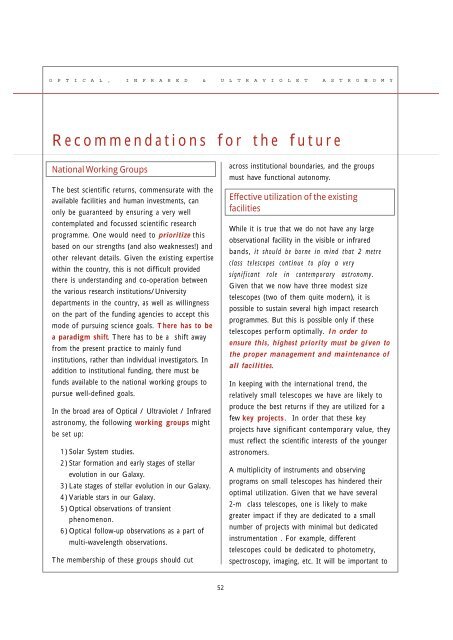2004 ASTRONOMY & ASTROPHYSICS - Indian Academy of Sciences
2004 ASTRONOMY & ASTROPHYSICS - Indian Academy of Sciences
2004 ASTRONOMY & ASTROPHYSICS - Indian Academy of Sciences
Create successful ePaper yourself
Turn your PDF publications into a flip-book with our unique Google optimized e-Paper software.
OPTICAL, INFRARED & ULTRAVIOLET <strong>ASTRONOMY</strong><br />
Recommendations for the future<br />
National Working Groups<br />
The best scientific returns, commensurate with the<br />
available facilities and human investments, can<br />
only be guaranteed by ensuring a very well<br />
contemplated and focussed scientific research<br />
programme. One would need to prioritize this<br />
based on our strengths (and also weaknesses!) and<br />
other relevant details. Given the existing expertise<br />
within the country, this is not difficult provided<br />
there is understanding and co-operation between<br />
the various research institutions/University<br />
departments in the country, as well as willingness<br />
on the part <strong>of</strong> the funding agencies to accept this<br />
mode <strong>of</strong> pursuing science goals. There has to be<br />
a paradigm shift. There has to be a shift away<br />
from the present practice to mainly fund<br />
institutions, rather than individual investigators. In<br />
addition to institutional funding, there must be<br />
funds available to the national working groups to<br />
pursue well-defined goals.<br />
In the broad area <strong>of</strong> Optical / Ultraviolet / Infrared<br />
astronomy, the following working groups might<br />
be set up:<br />
1)Solar System studies.<br />
2)Star formation and early stages <strong>of</strong> stellar<br />
evolution in our Galaxy.<br />
3)Late stages <strong>of</strong> stellar evolution in our Galaxy.<br />
4)Variable stars in our Galaxy.<br />
5)Optical observations <strong>of</strong> transient<br />
phenomenon.<br />
6)Optical follow-up observations as a part <strong>of</strong><br />
multi-wavelength observations.<br />
The membership <strong>of</strong> these groups should cut<br />
across institutional boundaries, and the groups<br />
must have functional autonomy.<br />
Effective utilization <strong>of</strong> the existing<br />
facilities<br />
While it is true that we do not have any large<br />
observational facility in the visible or infrared<br />
bands, it should be borne in mind that 2 metre<br />
class telescopes continue to play a very<br />
significant role in contemporary astronomy.<br />
Given that we now have three modest size<br />
telescopes (two <strong>of</strong> them quite modern), it is<br />
possible to sustain several high impact research<br />
programmes. But this is possible only if these<br />
telescopes perform optimally. In order to<br />
ensure this, highest priority must be given to<br />
the proper management and maintenance <strong>of</strong><br />
all facilities.<br />
In keeping with the international trend, the<br />
relatively small telescopes we have are likely to<br />
produce the best returns if they are utilized for a<br />
few key projects. In order that these key<br />
projects have significant contemporary value, they<br />
must reflect the scientific interests <strong>of</strong> the younger<br />
astronomers.<br />
A multiplicity <strong>of</strong> instruments and observing<br />
programs on small telescopes has hindered their<br />
optimal utilization. Given that we have several<br />
2-m class telescopes, one is likely to make<br />
greater impact if they are dedicated to a small<br />
number <strong>of</strong> projects with minimal but dedicated<br />
instrumentation . For example, different<br />
telescopes could be dedicated to photometry,<br />
spectroscopy, imaging, etc. It will be important to<br />
52
















